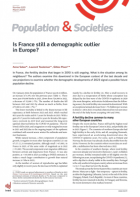
@@src2@@
Changes in Family Situations as Reflected in the French Censuses, 1962-2009
Collection : Demographic situation
2012, 26 pages
Censuses provide a means to count the population and to describe its main characteristics at all geographical levels. French census data from 1962 to 2006 are available via the IPUMS-I project of the University of Minnesota, and data for the years 2006-2009 are accessible on the INSEE website, so changes in family situations over the last fifty years can be described in detail. With the fertility decline and population ageing, the proportion of "children" has decreased. The other major changes (increasing share of persons living alone or in lone-parent families, fewer situations of co-residence with adult children or other relatives) follow very different patterns by sex and age. The same is often true for disparities between social groups (identified by occupational group, educational level or place of residence) and their evolution. The switch to annual census surveys in France provides new opportunities for analysing annual data, at least at national or regional scale, even though the census is designed to group the data from five successive annual waves.
This article is accessible online in the "Download(s)" box






















